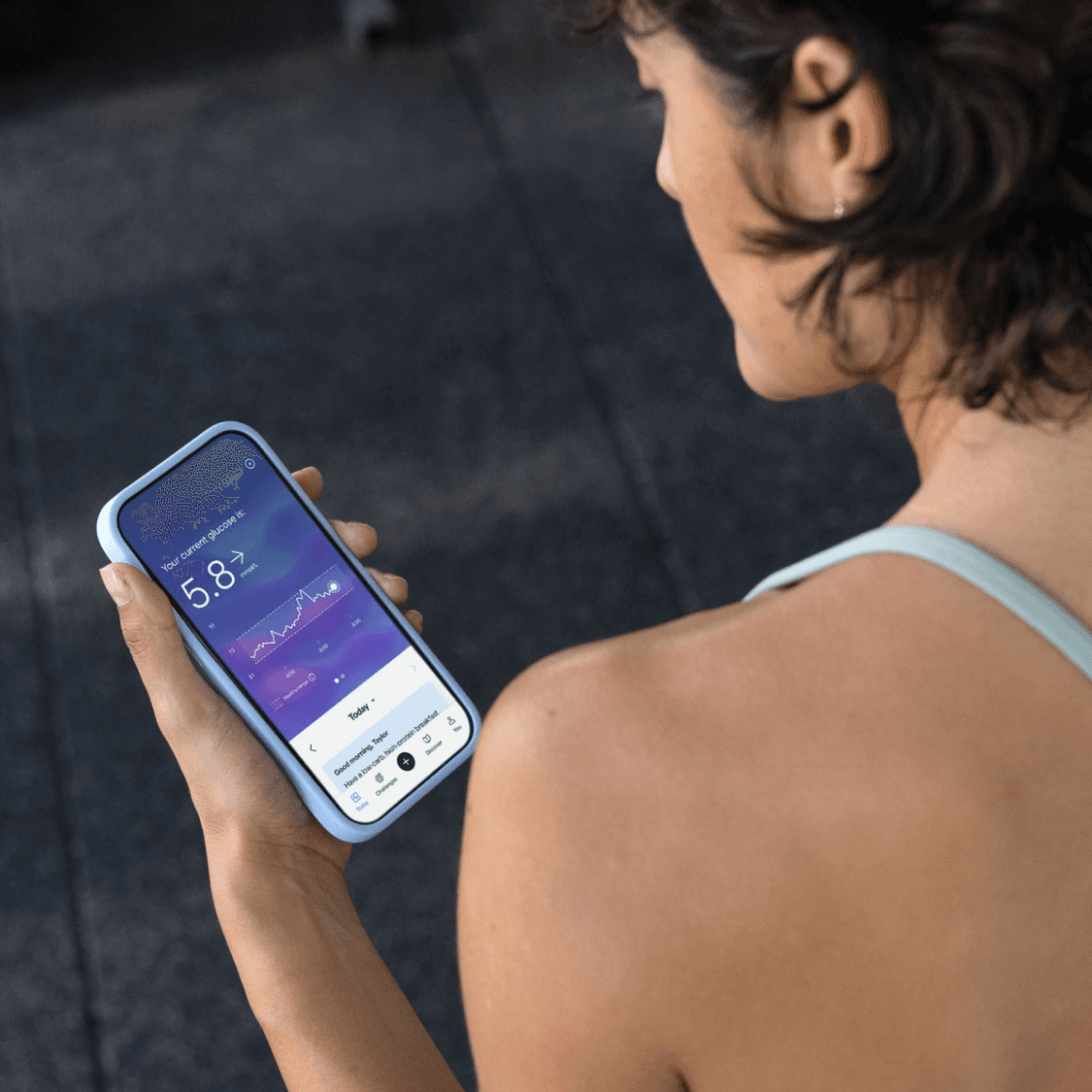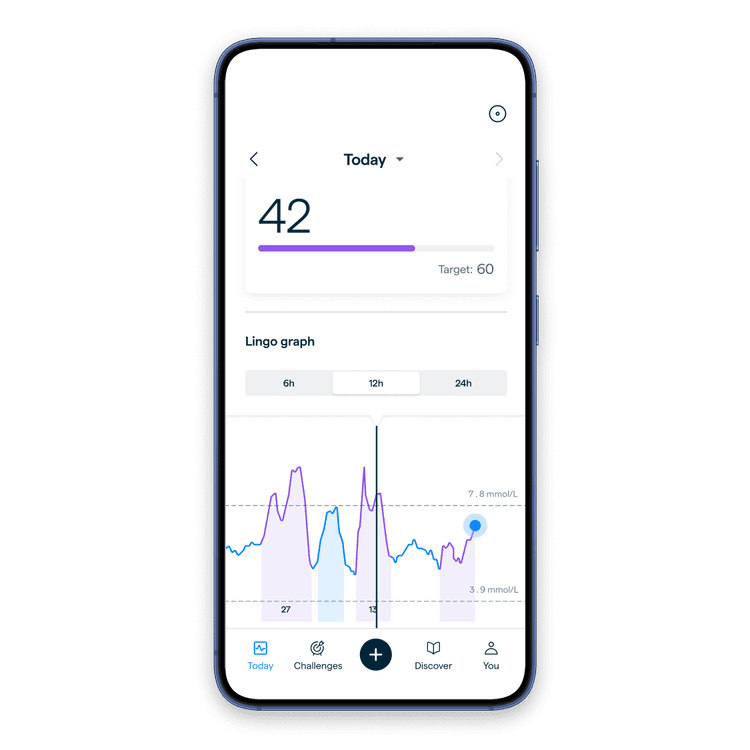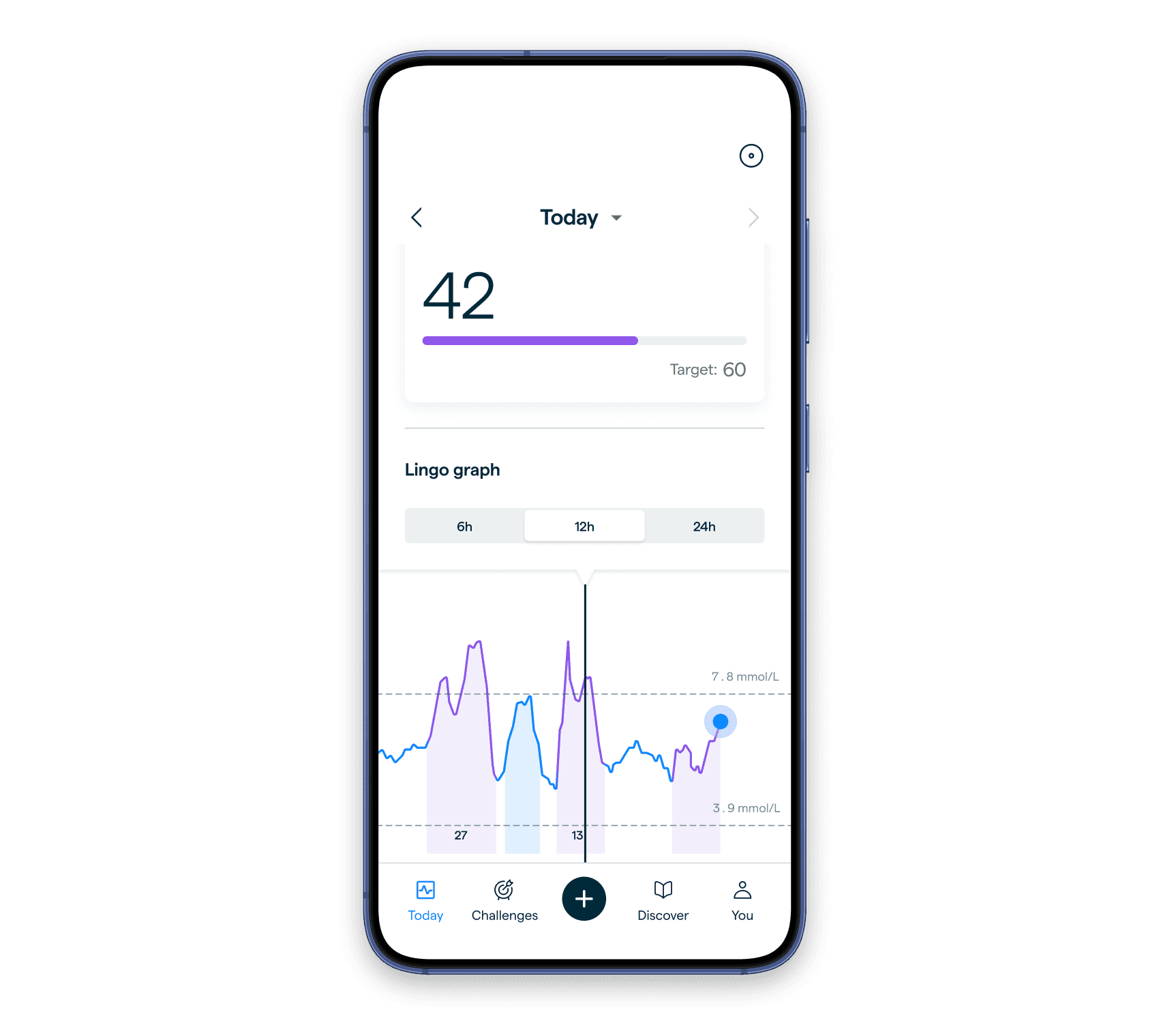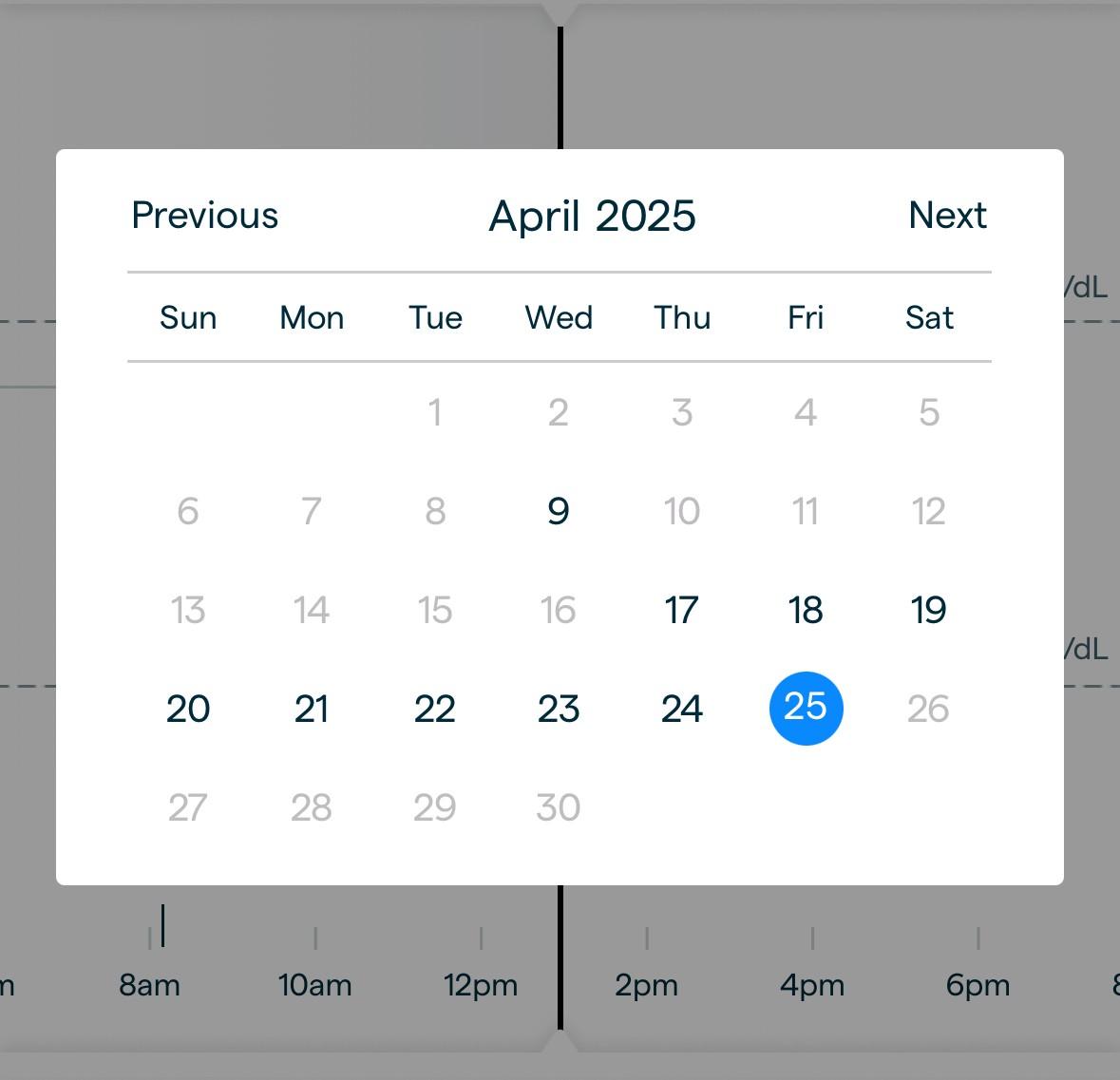Living with Lingo: What it’s really like to use a CGM every day
What can you expect from wearing a continuous glucose monitor? Learn about life with Lingo, plus tips for getting the most out of your Lingo journey.
Christina Stiehl,
Managing Editor
Sarah Koenck, MS, RD,
Medical Affairs
Published:
October 27, 2025
Read time:
10 minutes

What you need to know:
Lingo is a continuous glucose monitor, or CGM, worn on the arm for up to 14 days. Lingo helps you analyse your unique responses to food, activity, and other lifestyle habits.
The Lingo app coaches you through your glucose ups and downs to help you establish healthy behaviour change and help mitigate glucose spikes that may impact your energy, mood, cravings, and more.1
There are several lifestyle habits and tips we suggest that may help reduce glucose spikes, improve metabolic health, and get the most out of your Lingo experience.
Start Lingo today for just £59
Learn how your body responds to food and exercise with a 2-week plan*, no commitment.
Buy now
Lingo is a biowearable continuous glucose monitoring system designed to help you understand your body’s glucose response to food, activity, sleep, and more so you can build healthier habits that work for you. At the core of the Lingo experience is the biosensor: a discreet, coin-sized continuous glucose monitor (CGM) you wear on the back of your arm that monitors your glucose 24/7.
The Lingo app helps you glean insights into your unique glucose data. Using your real-time glucose graph, Lingo graph, Lingo Count, and in-app content, Lingo helps you track your glucose response and establish healthier habits that can impact your energy, cravings, sleep, mood, and more.1
Below, we outline what it’s like to wear a Lingo biosensor and tips for incorporating Lingo into your everyday life. With Lingo, the goal isn’t to eliminate your favourite meals or avoid glucose spikes entirely. With simple adjustments, you can identify the foods, habits, and activities that benefit both your glucose and daily wellbeing, and work towards establishing healthy habits that support you feeling your best.
Using the Lingo biosensor and app for glucose insights
The Lingo biosensor is a continuous glucose monitor (CGM) that measures glucose levels in your interstitial fluid (the thin layer of fluid surrounding your cells), and streams real-time data straight to your phone, 24/7. CGM readings from interstitial fluid are converted to approximate blood glucose levels. While they tend to trend similarly, CGM may lag behind actual blood glucose by about five to 15 minutes.
Lingo connects to your phone wirelessly using Bluetooth. The Lingo biosensor is worn on the back of your arm and stays in place with an adhesive, allowing the biosensor to be used for up to 14 days with no charge.
As Lingo monitors your glucose and streams this data to your phone in near-real time, it gives you insights into your unique response to habits, including the meals you eat, your workouts, and how you slept the night before.
Your glucose rises most commonly after eating carbohydrates, especially if eaten by itself without a source of protein or fat — what we call “naked carbs.”2 However, intense exercise, stress, or poor sleep can also cause your glucose to rise.3,4,5
A sharp, marked rise in glucose is known as a glucose spike and will show in your Lingo graph. Some glucose spikes can be followed by a comparable decline, also known as a dip or crash.
In the short term, a glucose spike and then crash might leave you feeling cranky, tired, or suddenly craving another snack.6,7 Over time, frequent high glucose fluctuations can negatively impact the health of blood vessels and cells, with persistent spikes outside of the healthy glucose range paving the way for potential metabolic disorders.8,9
Consistently elevated glucose levels or frequent spikes outside of the healthy glucose range can contribute to insulin resistance and type 2 diabetes, induce inflammation, and compromise blood vessel health, which can lead to cardiovascular conditions such as heart disease.10,11,8 Lingo helps you recognise when these spikes happen and teaches you what steps you can take to avoid frequent glucose spikes in the future.
Understanding your glucose graph, Lingo graph, and Lingo Count
In the Lingo app, you’ll be able to track your glucose through a visual glucose graph and corresponding Lingo graph. The real-time glucose graph shows:
Your current real-time glucose reading in mmol/L (millimoles per litre).
An arrow that indicates how your glucose is trending: rising, steady, or dropping.
Healthy range lines that indicate a healthy glucose range in the body.
The glucose levels for typically metabolically healthy people range between 3.9-7.8 mmol/L (millimoles per litre),12,13 although it’s normal for glucose to fall outside of this range occasionally.12 People without diabetes spend on average less than one hour per day outside of this range. Most healthy individuals stay below the 7.8 mmol/L level even during a spike and return to normal levels within a few hours.12
Your Lingo graph shows your glucose levels rising and falling throughout the day, helping you connect the dots between your habits and your unique glucose responses.


Your Lingo graph gives you a clear visual of your glucose patterns throughout the day. The Lingo graph includes:
Colour shading: purple indicates glucose spikes that you should pay attention to; blue indicates exercise-related spikes.
Time tabs that show your glucose levels over a 6-, 12-, or 24-hour time period. You can toggle among all three to see your glucose over these ranges of time.
Healthy range lines showing a healthy or “normal” glucose range in the body (like the glucose graph shows).
Event markers that denote logged food, drink, exercise, or other events.
You’ll also see something called a Lingo Count: a daily number that reflects your overall glucose exposure. When glucose spikes, Lingo assigns a numeric Lingo Count value based on the size and duration of the spike. In your Lingo graph, Lingo Count is assigned to the purple spikes and contribute to your daily Lingo Count number. The higher and/or longer your spikes are, the more your Lingo Count number will increase.
The goal is to stay within your personal Lingo Count target, which may adjust each week based on your data. The Lingo graph helps you identify what is causing the highest Lingo Count, connecting those spikes with your mood, energy, focus, sleep, hunger, cravings, and more. This helps you try different habits to reduce these spikes, reduce Lingo Count, and hopefully improve how you feel.


While your glucose data is stored in your Lingo graph, you can scroll back indefinitely or click on the calendar above the Lingo graph to view any specific day you had the sensor on to view this historical data.
When you eat food, it takes time for the CGM to register this change. The typical response time is generally about 30 minutes after eating but may be a bit shorter or longer depending on the type of food. It takes about 50 minutes after eating for the Lingo Count spike detection algorithm to denote a spike and Lingo Count value.
When something causes a spike — whether it’s a carb-heavy meal, a poor night’s sleep, or just everyday stress — you’ll get a coaching message in the app to help you understand what happened and what to do next. Over time, these nudges are designed to build awareness and empower habit change, one insight at a time.
Logging events and understanding your unique glucose response
The app also lets you log your meals, activity, and other events at specific times of the day by tapping the plus (+) icon and selecting a category: Food & Drink, Exercise, or Other (like a stressful meeting or poor sleep). Logging these events helps you notice patterns and how your glucose responds. We recommend tracking all of your meals and activity in the app as soon as they happen to get the most out of your personal glucose data.
In the Lingo graph, you can click the (+) underneath a spike to add an event so you can start to correlate how a specific meal or event is connected to larger spikes.
Once you wear Lingo for a few days, you can start to glean insights into your glucose data. By consistently logging your daily events, Lingo helps you identify patterns you might otherwise miss, like how the same foods may impact you differently if eaten at night versus lunchtime, or if walking after a meal helps mitigate a spike. If you wear an Apple Watch, the activity logged in your Apple Watch will automatically transfer to the Lingo app if you decide to pair Lingo with Apple Health.
Glucose spikes happen, and the goal of Lingo isn’t to avoid spikes completely. Lingo helps you learn how these spikes impact your mood, focus, hunger, or overall wellbeing, and encourages you to make healthier changes to reduce these spikes and hopefully improve how you feel. Another goal of Lingo is to lessen frequent large spikes (over 7.8 mmol/L) to help reduce the risk of long-term health consequences9 and improve overall health and wellbeing.1
Your glucose graph, Lingo graph, and Lingo Count all can help you identify what triggered your glucose spikes and how that made you feel so you can make more glucose-friendly choices at your next meal. If you have questions about your glucose values, be sure to check in with your health care team. It’s important to note that Lingo is not to be used for the diagnosis or treatment of any disease, including diabetes. Lingo also isn’t intended for users who are on insulin.
Everyday tips to make the most out of your Lingo journey
Once you’re wearing your biosensor and seeing your glucose data in real time, you may feel inspired to make tweaks to your eating and activity habits. Here are a few Lingo-approved tips to get the most out Lingo and help manage your glucose levels:
Log consistently: Log your food and activity in the Lingo app as often as you can so you can notice what habits influence your glucose data and how you’re feeling.
Prioritise protein: We recommend adults to eat about 1.5 g of protein per kilogram of desired bodyweight (for 68 kilograms, that means eating 102 g of protein per day), though individual needs may vary based on age, activity levels, personal health goals, and more. Aim for 25-30 g at breakfast, and try to eat the protein on your plate before the carbs.
Don’t eat “naked” carbs: Always pair carbs with a source of protein or fibre (or even better, protein and fibre) to help slow digestion and blunt a potential spike.14, 2
Fuel with healthy fats and fibre: Healthy fats like avocado, olive oil, and some nuts can help keep your glucose steady14 while supporting essential vitamin and mineral absorption and overall health.15 Fibre-rich foods like leafy greens and non-starchy vegetables help slow down glucose absorption16,17 and support gut health.
Get moving: Regular exercise can help support glucose management. Strength training helps facilitate muscle growth, which can help regulate glucose,18 and moving after eating may help blunt a glucose spike.19
Drink mindfully: When drinking alcohol, choose low-carb options, avoid drinking on an empty stomach, and aim for moderation (no more than 14 units of alcohol a week, spread across three or more days).20
Stay hydrated: Maintaining proper hydration is important for physical and cognitive performance and may reduce the risk of developing hyperglycaemia over time.21 Women should aim for 90 ounces of water daily, while men should target 125 ounces.22
Take your Lingo journey one choice at a time: You don’t need to be perfect, and beating yourself up after eating foods that cause a spike isn’t helpful. The goal is to be curious and consistent: each meal is an opportunity to make a choice that supports your glucose health and metabolic wellbeing.
A final note from Lingo
Living with Lingo isn’t about following strict rules; it’s about learning what works for you. With your biosensor and the Lingo app as your guide, you’ll start to recognise how small choices can add up to lasting results. Whether it’s adjusting your breakfast, adding a walk after lunch, or logging meals to spot trends, you’ll start to gain new insights into your metabolism and how to support it day by day.
Behaviour change doesn’t happen overnight, but having a lens into your unique glucose data can set you up for success to create healthier habits that support your health and wellbeing goals.23,24 Ready to start your own Lingo journey? Click here to get started.
The Lingo system is not for medical use and intended for users 18 years and older. Lingo is not intended for diagnosis or management of any disease including diabetes.
The Lingo programme does not guarantee that everyone will achieve the same results as individual responses may vary. It is best to speak to your doctor for advice on starting any diet or exercise regime or if you have an eating disorder or a history of eating disorders.
© 2025 Abbott. All rights reserved. The biosensor shape and appearance, Lingo, and related brand marks are marks and/or designs of the Abbott group of companies in various territories. Other marks are the property of their respective owners.
ALB-03559
Published:
October 27, 2025
Read time:
10 minutes


Christina Stiehl is the Managing Editor at Lingo. She graduated from the University of Missouri School of Journalism and has more than a decade of professional editorial experience in the health and wellness industry. Christina has written for top media publications including SELF, PS, Shape, Well+Good, Thrillist, and VICE before pivoting to leading content at health tech companies.


Sarah Koenck, MS, RD, is a Medical Affairs Specialist at Lingo. She’s been a registered dietitian since 2011 and has a master's degree in kinesiology from A.T. Still University. She spent the first part of her career as a clinical dietitian in the ICU before moving onto specialising in diabetes and weight management in the digital health space. Her personal health journey, including living with type 1 diabetes for almost 30 years and wearing a continuous glucose monitor for almost 20, has driven her commitment to help others at Lingo.
A healthy choice for your inbox
Sign up for Lingo emails to get science-backed tips, special offers, and The Journey Newsletter.
Start Lingo today
for just £59
Learn how your body responds to food and exercise with a 2-week plan*, no commitment.
- 1 Lingo biosensor with minute-by-minute continuous glucose tracking
- Full access to the Lingo app. Designed for iPhone 11 device or later.
Shop now
Free shipping
*No commitment. This plan does not auto-renew (requires an iPhone 11 or later)

